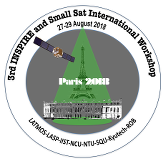Speaker
Dr
Vincent Lapeyrere
(LESIA, Observatoire de Paris, Université PSL, CNRS, Sorbonne Université, Univ. Paris Diderot, Sorbonne Paris Cité)
Description
PicSat was a three unit CubeSat (measuring 30 cm × 10 cm × 10 cm) which was developed to monitor the β Pictoris system. The main science objective was the detection of a possible transit of the giant planet β Pictoris b’s Hill sphere. Secondary objectives included studying the circumstellar disk, and detecting exocomets in the visible band. The mission also had a technical objective: demonstrate our ability to inject starlight in a single mode fiber, on a small satellite platform. To answer all those objectives, a dedicated opto-mechanical payload was built, and integrated in a commercial 3U platform, along with a commercial ADCS (Attitude Determination and Control System).
The satellite successfully reached Low Earth Orbit on the PSLV-C40 rocket, on January, 12, 2018. Unfortunately, on March, 20, 2018, after 10 weeks of operations, the satellite fell silent, and the mission came to an early end. Furthermore, due to a failure of the ADCS, the satellite never actually pointed toward its target star during the 10 weeks of operations. In this presentation, we report on the PicSat mission development process, and on the reasons why it did not deliver any useful astronomical data.
Primary author
Dr
Vincent Lapeyrere
(LESIA, Observatoire de Paris, Université PSL, CNRS, Sorbonne Université, Univ. Paris Diderot, Sorbonne Paris Cité)
Co-authors
Dr
Antoine Crouzier
(LESIA, Observatoire de Paris, Université PSL, CNRS, Sorbonne Université, Univ. Paris Diderot, Sorbonne Paris Cité)
Mr
Lester David
(LESIA, Observatoire de Paris, Université PSL, CNRS, Sorbonne Université, Univ. Paris Diderot, Sorbonne Paris Cité)
Mr
Mathias Nowak
(LESIA, Observatoire de Paris, Université PSL, CNRS, Sorbonne Université, Univ. Paris Diderot, Sorbonne Paris Cité)
Dr
Sylvestre Lacour
(LESIA, Observatoire de Paris, Université PSL, CNRS, Sorbonne Université, Univ. Paris Diderot, Sorbonne Paris Cité)

